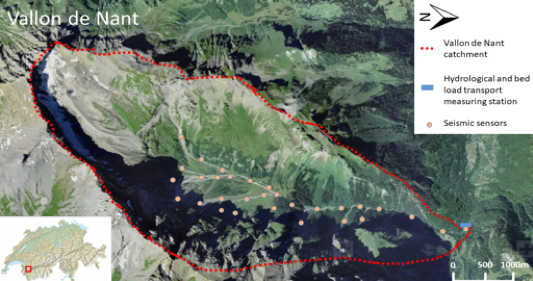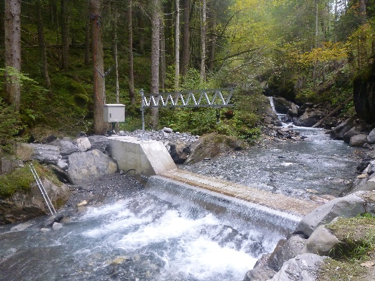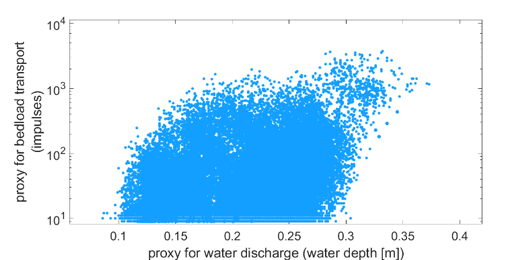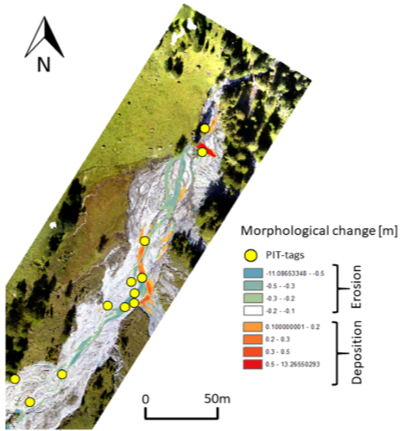Bedload transport in mountain rivers remains one of the most elusive geomorphologic processes at the Earth’s surface and, as such, the fluvial geomorphology community still does not understand the magnitude-frequency relationships linked to this process (Rainato et al., 2018; Recking, 2012; Turowski et al., 2011; Yager et al., 2015). Understanding bedload transport matters for river management, notably regarding flood risk mitigation, hydropower production, river engineering projects and river restoration projects. Those aspects are particularly critical in mountain environments, where steep gradients produce flows with high transport capacity while sources of coarse sediment are abundant, in addition to the risk that climate change will increase the frequency of extreme events in these areas.
The goal of this PhD project is to relate bedload transport time-series measured at the outlet of an Alpine catchment – the Vallon de Nant (Alpes vaudoises) – to the spatial motion of coarse sediment across the basin, in order to better constraint the magnitude-frequency of bedload transport. In this project, we profit from two critical elements. First, the Vallon de Nant, UNIL’s experimental mountain river basin, is equipped with a calibrated station that continuously and simultaneously records water discharge and bedload transport, the latter using geophone sensors (e.g. Rickenmann, 2017). The second, progress with field methods to monitor the spatial motion of bedload. This includes (a) the repeated acquisition of high-resolution digital elevation models to quantify morphological changes (e.g. Antoniazza et al., 2019), notably using UAVs (e.g. James et al., in press), (b) the monitoring of bedload transport using environmental seismology (e.g. Dietze et al., 2019) and (c) the tracking of particles using RFID PIT-tags technology (e.g. Hassan and Ergenzinger, 2003). This project combines those different approaches in a novative way in order to understand how changes in sediment availability in the catchment produce inconsistencies in water and bedload discharge at the outlet, in the perspective of better constraining the changes in bedload magnitude-frequency relationships.
 |
 |
| Fig. 1: the Vallon de Nant catchment (Alpes vaudoises) equiped with a network of seismic sensors to monitor the motion of coarse sediment across the basin. | Fig. 2: the UNIL-WSL calibrated gauging station for continuous water discharge and bedload transport monitoring. |
 |
 |
| Fig. 3: order(s) of magnitude variability between water discharge and bedload transport relationship measured at the UNIL-WSL gauging station, April to September 2016; each point represents the bedload magnitude associated to a given water discharge. Acknowledgments Mettra et al. (in prep.). | Fig. 4: combination of repeated UAV surveys to measure volumetric changes related to bedload transport, and individual particle tracking using RFID technology, to understand how coarse sediment move across the basin. |
References
Antoniazza, G., Bakker, M., Lane, S.N., 2019. Revisiting the morphological method in two-dimensions to quantify bed-material transport in braided rivers. Earth Surface Processes and Landforms 44, 2251–2267. https://doi.org/10.1002/esp.4633
Dietze, M., Lagarde, S., Halfi, E., Laronne, J.B., Turowski, J.M., 2019. Joint Sensing of Bedload Flux and Water Depth by Seismic Data Inversion. Water Resources Research 55, 9892–9904. https://doi.org/10.1029/2019WR026072
Hassan, M.A., Ergenzinger, P., 2003. Use of tracers in fluvial geomorphology. Tools in fluvial geomorphology 397–423.
Mettra, F., Antoniazza, G., Rickenmann, D. and Lane, S.N. (in preparation). Coarse sediment production, transfer and export in a small snow-dominated Alpine catchment. To be submitted to Water Resources Research. Work completed, paper being written.
Rainato, R., Mao, L., Picco, L., 2018. Near-bankfull floods in an Alpine stream: Effects on the sediment mobility and bedload magnitude. International Journal of Sediment Research 33, 27–34. https://doi.org/10.1016/j.ijsrc.2017.03.006
Recking, A., 2012. Influence of sediment supply on mountain streams bedload transport. Geomorphology 175–176, 139–150. https://doi.org/10.1016/j.geomorph.2012.07.005
Rickenmann, D., 2017. Bedload transport measurements with geophones, hydrophones and underwater microphones (passive acoustic methods). Gravel Bed Rivers and Disasters, Wiley & Sons, Chichester, UK 185–208.
Turowski, J.M., Badoux, A., Rickenmann, D., 2011. Start and end of bedload transport in gravel-bed streams. Geophysical Research Letters 38. https://doi.org/10.1029/2010GL046558
Yager, E.M., Kenworthy, M., Monsalve, A., 2015. Taking the river inside: Fundamental advances from laboratory experiments in measuring and understanding bedload transport processes. Geomorphology, Laboratory Experiments in Geomorphology 46th Annual Binghamton Geomorphology Symposium 18-20 September 2015 244, 21–32. https://doi.org/10.1016/j.geomorph.2015.04.002
